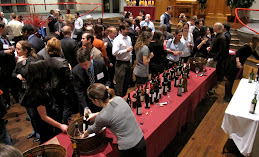This week students in Professor Percival’s Global Environmental Law seminar completed updated profiles of the state of environmental law in 54 countries. Each of the 27 students in the seminar selected two countries to update. Based on student reports about their research, it seems apparent that each year it is becoming easier to find research material on the state of environmental law even in countries that are not household names. The updated profiles are being posted to Professor Percival's website at: www.globalenvironmentallaw.com. To view them, simply visit that website and click on the “Country Profiles” link at the top of the welcoming page.
A major positive development for global environmental law this week came on Friday when more than 140 nations agreed on a framework for negotiating a global treaty to reduce mercury pollution. At a meeting in Nairobi of the United Nations Environment Programme’s Governing Council, environmental ministers agreed to begin negotiations on a binding treaty to reduce mercury pollution. Negotiation of the treaty will commence later this year in the hopes of concluding a final agreement by the year 2013. The decision was the culmination of seven years of discussions on how to deal with global mercury pollution problems. Mercury emissions from coal-fired powerplants have become a particularly worrisome problem. Scientists estimate that as much as one-third of the mercury in the United States west of the Mississippi River is the result of mercury emissions from Chinese powerplants.
The key breakthrough in the negotiations came when the Obama administration reversed the Bush administration’s long-standing resistance to negotiating a global mercury treaty. After the U.S. changed its position, China and India also endorsed negotiating a global treaty. My former colleague Susan Egan Keene, who is now a policy analyst at the Natural Resources Defense Council (NRDC), attended the Nairobi meeting and described the agreement as “an amazing and astonishing turn of events.” For several years Susan has been working on a project to investigate sources of mercury pollution in China. I saw her last year when she was in Beijing for the launch of a project between NRDC and the Center for Legal Assistance for Pollution Victims (CLAPV).
I certainly hope that the decisions by China and India to join the U.S. in endorsing negotiation of a global mercury treaty may presage a new willingness of these countries to join the U.S. in a new global climate change treaty. The Obama administration already has signaled that it will reverse the Bush administration’s opposition to binding controls on greenhouse gas (GHG) emissions. Last week EPA administrator Lisa P. Jackson announced that she would reconsider the Bush administration’s decision not to regulate emissions of carbon dioxide from new coal-fired powerplants. The emphasis Secretary of State Clinton placed on climate change issues during her visit to Beijing last week indicates that the U.S. will fully engage China in an effort to get that country to join in the new global regime to control GHG emissions, which will be negotiated in Copenhagen in December. Since China is now the world’s largest source of both mercury emissions and GHG emissions, its participation is crucial to the success of global efforts to respond to climate change.
On Saturday night I had dinner with Tseming Yang and three of the Chinese participants in the Vermont Law School Partnership for Environmental Law in China. They were in Washington on their way back from a conference at Washington & Lee School of Law on “Climate Policy for the Obama Administration.” The VLS/China project is flourishing and consuming most of Tseming’s time these days.
Sunday, February 22, 2009
Sunday, February 15, 2009
Lawrence Friedman Visit & RFA for Latin American Partnerships
On Wednesday February 11, renowned legal historian and comparative law expert Lawrence Friedman, the Marion Rice Kirkwood Professor of Law at Stanford Law School, visited the University of Maryland School of Law. While in law school at Stanford I served as a research assistant to Professor Friedman and we ultimately co-authored a book (The Roots of Justice) and two articles (including “A Tale of Two Courts”). Friedman inspired me to become a law professor and he has been a wonderful mentor to me over the years. I have long wanted him to visit Maryland and I was delighted when our faculty agreed to invite him and he accepted the invitation. He spoke to the faculty about his forthcoming book “Dead Hands,” which will be published next month by Stanford University Press.
Professor Friedman is a truly remarkable human being and, for me at least, the very model of what a law professor should aspire to be. He is the author of the classic “A History of American Law,” and “Dead Hands” will be the 27th book he has written. He is the author of more than 200 articles and is (by far) the most-cited legal historian in the world. On Tuesday I met him at Dulles airport and my wife and I had a wonderful dinner with him in D.C. on Tuesday night. In his talk to the faculty on Wednesday, Lawrence made a compelling case for the importance of research on how the legal system facilitates wealth transfers, a topic that too often is considered a legal backwater. His forthcoming book examines how the law of trusts and estates and property law have evolved over time in response to significant changes in society and families. Professor Friedman’s talk sparked a lively debate among the faculty over why the Bush administration was able to garner so much political support for eliminating the estate tax.
Because I had long ago agreed to serve as the host for Lawrence’s visit, this week I rescheduled my Environmental Law class at Harvard, which normally is taught on Wednesdays, for Friday. I flew up to Boston on Friday morning and taught a class on the common law roots of environmental law on Friday afternoon.
The U.S. Agency for International Development (AID) has issued a Request for Applications (RFA) for an environmental law capacity-building project to assist law schools in the Dominican Republic, Guatemala and Nicaragua. The project will fund a collaborative environmental law partnership between a U.S. law school and schools in these three other countries, similar to the partnership AID has funded between Vermont Law School and Sun Yat-sen University in Guangzhou, China. This looks like a wonderful opportunity. Further information about the project is available in the RFA, which can be viewed online at: http://www.hedprogram.org/tabid/66/itemid/174/CAFTADR-Environmental-Law-Capacity-Building-Initi.aspx
Professor Friedman is a truly remarkable human being and, for me at least, the very model of what a law professor should aspire to be. He is the author of the classic “A History of American Law,” and “Dead Hands” will be the 27th book he has written. He is the author of more than 200 articles and is (by far) the most-cited legal historian in the world. On Tuesday I met him at Dulles airport and my wife and I had a wonderful dinner with him in D.C. on Tuesday night. In his talk to the faculty on Wednesday, Lawrence made a compelling case for the importance of research on how the legal system facilitates wealth transfers, a topic that too often is considered a legal backwater. His forthcoming book examines how the law of trusts and estates and property law have evolved over time in response to significant changes in society and families. Professor Friedman’s talk sparked a lively debate among the faculty over why the Bush administration was able to garner so much political support for eliminating the estate tax.
Because I had long ago agreed to serve as the host for Lawrence’s visit, this week I rescheduled my Environmental Law class at Harvard, which normally is taught on Wednesdays, for Friday. I flew up to Boston on Friday morning and taught a class on the common law roots of environmental law on Friday afternoon.
The U.S. Agency for International Development (AID) has issued a Request for Applications (RFA) for an environmental law capacity-building project to assist law schools in the Dominican Republic, Guatemala and Nicaragua. The project will fund a collaborative environmental law partnership between a U.S. law school and schools in these three other countries, similar to the partnership AID has funded between Vermont Law School and Sun Yat-sen University in Guangzhou, China. This looks like a wonderful opportunity. Further information about the project is available in the RFA, which can be viewed online at: http://www.hedprogram.org/tabid/66/itemid/174/CAFTADR-Environmental-Law-Capacity-Building-Initi.aspx
Sunday, February 8, 2009
International Moot Court, ALI-ABA & Export Credit Settlement
On Friday and Saturday the University of Maryland School of Law hosted the North American Finals (Atlantic Round) of the International Environmental Moot Court Competition. Teams from twelve law schools in the U.S. and Canada participated in the competition. Three preliminary rounds were held on Friday with the teams arguing a hypothetical case before the International Court of Justice concerning one country’s seizure of another country’s fishing boat allegedly overfishing krill in Antarctic waters.
On Friday night more than 100 participants, judges, and student volunteers were hosted to a dinner in Westminster Hall where they heard Zhang Jingjing, one of the top public interest environmental lawyers in China, deliver the first annual Fedder Lecture. Jingjing, who participated in my environmental law course last year in Beijing, gave a truly inspiring lecture about the state of environmental citizen activism in China. Maryland alum Joel Fedder, who has been a great supporter of our Environmental Law Program, closed the evening with a moving message. Photos of the dinner and lecture will be posted online shortly and this blog entry will be updated with a weblink to them.
Following the dinner the eight teams advancing to the quarterfinal rounds were announced. After the quarterfinals were held on Saturday morning, teams from Cleveland-Marshall, Florida State, John Marshall, and Wake Forest advanced to the semifinal round. This was followed by the final round, which featured the top teams representing the applicant (Cleveland-Marshall) and respondent (John Marshall).
The competition was blessed with an extraordinarily well-qualified group of judges. These included many alums of Maryland’s Environmental Law Program and other experts in international environmental law. The judges for the final round were: Dan Magraw (president of the Center for International Environmental Law), Paul Hagen (chairman of the board of the Environmental Law Institute), and Bruce Rich (director of international programs for the Environmental Defense Fund). After a terrific final round the judges declared the team of Danja Therecka and Carrie Lewine from Cleveland-Marshall College of Law as the winner. Both they and the runner-up team from John Marshall Law School will advance to the International Finals to be held at Stetson University School of Law on March 25-28. Congratulations to both teams and their coaches, Janice Aitken of Cleveland-Marshall and Steven Schwinn of John Marshall. Photos of the competition and the awards ceremony are available online at: http://gallery.me.com/rperci/100411.
On Wednesday I taught my first Environmental Law & Policy class at Harvard Law School. I have a large and seemingly enthusiastic group of law students in the class as well as more than a dozen students from outside the law school, including students from the School of Public Health and MIT. It was great to be reunited with Tom Potter, the same wonderful faculty assistant I had when I visited at Harvard in 2000. The atmosphere at the law school seems distinctly more student-friendly than it was nine years ago, a real accomplishment than can largely be credited to the work of outgoing dean Elena Kagan.
On Friday I spoke at the annual ALI-ABA conference on Environmental Law, which was held in Bethesda. I teamed up with John Cruden, acting head of the Justice Department’s Environment and Natural Resources Division, to present the annual “Supreme Court Roundup.” After discussing the Supreme Court’s Winter decision, we took turns discussing the other four core environmental cases being heard by the Supreme Court this Term. It was great to see some of my former students in the audience. Cruden announced that the Justice Department had just asked the Supreme Court to pull its cert petition challenging the D.C. Circuit’s decision striking down EPA’s mercury rule. While the Obama administration is taking its time filling up many sub-cabinet positions, it is moving quickly to reshape environmental policy in a positive direction. The real challenge ahead for it will be to reach agreement on a strategy for controlling greenhouse gas emissions.
Another indication of positive change by the Obama administration is a landmark settlement announced on Friday of a long-running NEPA lawsuit brought by Friends of the Earth (FOE), Greenpeace, Boulder, Colorado and three California cities. The suit, filed in federal district court in San Francisco in 2002, charged that the U.S. Export-Import Bank and the Overseas Private Investment Corporation (OPIC) had failed to consider the impact on global warming and climate change of their actions financing fossil fuel power projects in violation of the National Environmental Policy Act (NEPA). In the settlement, the agencies agreed to provide $500 million in financing for renewable energy projects over the next 10 years. The Export-Import Bank agreed to develop, in consultation with plaintiffs, a carbon policy that will include financing incentives for reducing greenhouse gas (GHG) emissions. It also agreed to evaluate GHG emissions when assessing fossil fuel project investments. OPIC agreed to set a goal of reducing by 20 percent the GHG emissions associated with the projects it funds over the next 10 years. It also agreed to include climate change impacts in the environmental assessment it performs of any projects it funds that emit more than 100,000 tons of carbon dioxide equivalents per year.
On Friday night more than 100 participants, judges, and student volunteers were hosted to a dinner in Westminster Hall where they heard Zhang Jingjing, one of the top public interest environmental lawyers in China, deliver the first annual Fedder Lecture. Jingjing, who participated in my environmental law course last year in Beijing, gave a truly inspiring lecture about the state of environmental citizen activism in China. Maryland alum Joel Fedder, who has been a great supporter of our Environmental Law Program, closed the evening with a moving message. Photos of the dinner and lecture will be posted online shortly and this blog entry will be updated with a weblink to them.
Following the dinner the eight teams advancing to the quarterfinal rounds were announced. After the quarterfinals were held on Saturday morning, teams from Cleveland-Marshall, Florida State, John Marshall, and Wake Forest advanced to the semifinal round. This was followed by the final round, which featured the top teams representing the applicant (Cleveland-Marshall) and respondent (John Marshall).
The competition was blessed with an extraordinarily well-qualified group of judges. These included many alums of Maryland’s Environmental Law Program and other experts in international environmental law. The judges for the final round were: Dan Magraw (president of the Center for International Environmental Law), Paul Hagen (chairman of the board of the Environmental Law Institute), and Bruce Rich (director of international programs for the Environmental Defense Fund). After a terrific final round the judges declared the team of Danja Therecka and Carrie Lewine from Cleveland-Marshall College of Law as the winner. Both they and the runner-up team from John Marshall Law School will advance to the International Finals to be held at Stetson University School of Law on March 25-28. Congratulations to both teams and their coaches, Janice Aitken of Cleveland-Marshall and Steven Schwinn of John Marshall. Photos of the competition and the awards ceremony are available online at: http://gallery.me.com/rperci/100411.
On Wednesday I taught my first Environmental Law & Policy class at Harvard Law School. I have a large and seemingly enthusiastic group of law students in the class as well as more than a dozen students from outside the law school, including students from the School of Public Health and MIT. It was great to be reunited with Tom Potter, the same wonderful faculty assistant I had when I visited at Harvard in 2000. The atmosphere at the law school seems distinctly more student-friendly than it was nine years ago, a real accomplishment than can largely be credited to the work of outgoing dean Elena Kagan.
On Friday I spoke at the annual ALI-ABA conference on Environmental Law, which was held in Bethesda. I teamed up with John Cruden, acting head of the Justice Department’s Environment and Natural Resources Division, to present the annual “Supreme Court Roundup.” After discussing the Supreme Court’s Winter decision, we took turns discussing the other four core environmental cases being heard by the Supreme Court this Term. It was great to see some of my former students in the audience. Cruden announced that the Justice Department had just asked the Supreme Court to pull its cert petition challenging the D.C. Circuit’s decision striking down EPA’s mercury rule. While the Obama administration is taking its time filling up many sub-cabinet positions, it is moving quickly to reshape environmental policy in a positive direction. The real challenge ahead for it will be to reach agreement on a strategy for controlling greenhouse gas emissions.
Another indication of positive change by the Obama administration is a landmark settlement announced on Friday of a long-running NEPA lawsuit brought by Friends of the Earth (FOE), Greenpeace, Boulder, Colorado and three California cities. The suit, filed in federal district court in San Francisco in 2002, charged that the U.S. Export-Import Bank and the Overseas Private Investment Corporation (OPIC) had failed to consider the impact on global warming and climate change of their actions financing fossil fuel power projects in violation of the National Environmental Policy Act (NEPA). In the settlement, the agencies agreed to provide $500 million in financing for renewable energy projects over the next 10 years. The Export-Import Bank agreed to develop, in consultation with plaintiffs, a carbon policy that will include financing incentives for reducing greenhouse gas (GHG) emissions. It also agreed to evaluate GHG emissions when assessing fossil fuel project investments. OPIC agreed to set a goal of reducing by 20 percent the GHG emissions associated with the projects it funds over the next 10 years. It also agreed to include climate change impacts in the environmental assessment it performs of any projects it funds that emit more than 100,000 tons of carbon dioxide equivalents per year.
Subscribe to:
Comments (Atom)

















